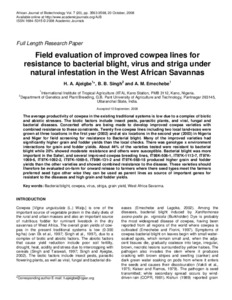| dc.contributor.author | Ajeigbe, Hakeem A. |
| dc.contributor.author | Singh, B.B. |
| dc.contributor.author | Emechebe, A.M. |
| dc.date.accessioned | 2019-12-04T11:14:43Z |
| dc.date.available | 2019-12-04T11:14:43Z |
| dc.date.issued | 2008-10 |
| dc.identifier.citation | Ajeigbe, H.A., Singh, B.B. & Emechebe, A.M. (2008). Field evaluation of improved cowpea lines for resistance to bacterial blight, virus and striga under natural infestation in the West African Savannas. African Journal of Biotechnology, 7(20), 3563-3568. |
| dc.identifier.issn | 1684-5315 |
| dc.identifier.uri | https://hdl.handle.net/20.500.12478/2840 |
| dc.description.abstract | The average productivity of cowpea in the existing traditional systems is low due to a complex of biotic
and abiotic stresses. The biotic factors include insect pests, parasitic plants, and viral, fungal and
bacterial diseases. Concerted efforts are being made to develop improved cowpea varieties with
combined resistance to these constraints. Twenty five cowpea lines including two local land-races were
grown at three locations in the first year (2002) and at six locations in the second year (2003) in Nigeria
and Niger for field screening for resistance to Bacterial blight. Many of the improved varieties had
significantly higher grain and fodder yields than the local checks. There was genotype x environment
interactions for grain and fodder yields. About 44% of the varieties tested were resistant to bacterial
blight while 20% showed moderate resistance and others were susceptible. Bacterial blight was more
important in the Sahel, and several improved cowpea breeding lines, IT98K-506-1, IT97K-1113-7, IT97K-
1069-6, IT97K-1092-2, IT97K-1069-5, IT98K-131-2 and IT97K-568-18 produced higher grain and fodder
yields than the other varieties and showed combined resistance to the disease. These varieties should
therefore be evaluated on-farm for onward release to farmers where there seed types meet the farmers
preferred seed type other wise they can be used as parent lines as source of important genes for
resistant to the diseases and high grain and fodder yields. |
| dc.language.iso | en |
| dc.subject | Bacterial Blight |
| dc.subject | Cowpeas |
| dc.subject | Virus |
| dc.subject | Striga |
| dc.subject | Yield |
| dc.subject | West Africa Savanna |
| dc.subject | Biotic And Abiotic Factors |
| dc.subject | Pathogen |
| dc.title | Field evaluation of improved cowpea lines for resistance to bacterial blight, virus and striga under natural infestation in the West African savannas |
| dc.type | Journal Article |
| dc.description.version | Peer Review |
| cg.contributor.affiliation | International Institute of Tropical Agriculture |
| cg.contributor.affiliation | University of Agriculture and Technology, Pantnagar |
| cg.coverage.region | Africa |
| cg.coverage.region | Acp |
| cg.coverage.region | West Africa |
| cg.coverage.region | East Asia |
| cg.coverage.country | Nigeria |
| cg.coverage.country | India |
| cg.isijournal | ISI Journal |
| cg.authorship.types | CGIAR and advanced research institute |
| cg.iitasubject | Plant Breeding |
| cg.iitasubject | Cowpea |
| cg.iitasubject | Plant Production |
| cg.iitasubject | Plant Genetic Resources |
| cg.iitasubject | Farming Systems |
| cg.iitasubject | Food Security |
| cg.iitasubject | Farm Management |
| cg.iitasubject | Plant Diseases |
| cg.iitasubject | Genetic Improvement |
| cg.iitasubject | Disease Control |
| cg.iitasubject | Pests Of Plants |
| cg.iitasubject | Crop Husbandry |
| cg.iitasubject | Handling, Transport, Storage And Protection Of Agricultural Products |
| cg.accessibilitystatus | Open Access |
| local.dspaceid | 93941 |

